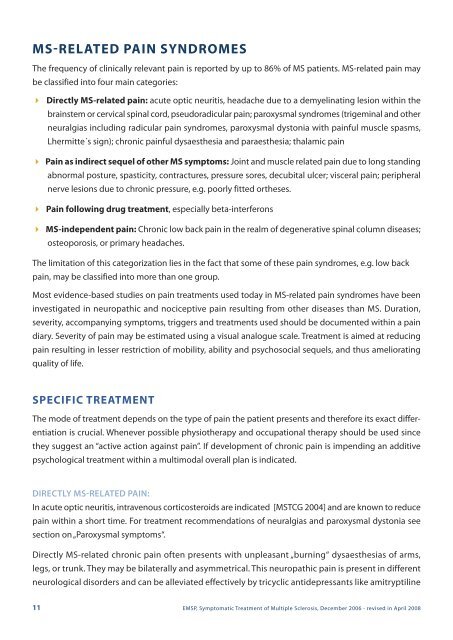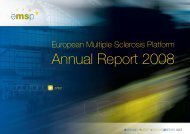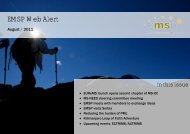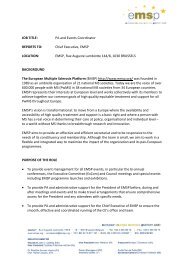Symptomatic Treatment of MS - European Multiple Sclerosis Platform
Symptomatic Treatment of MS - European Multiple Sclerosis Platform
Symptomatic Treatment of MS - European Multiple Sclerosis Platform
You also want an ePaper? Increase the reach of your titles
YUMPU automatically turns print PDFs into web optimized ePapers that Google loves.
<strong>MS</strong>-RELATED PAIN SYNDROMES<br />
The frequency <strong>of</strong> clinically relevant pain is reported by up to 86% <strong>of</strong> <strong>MS</strong> patients. <strong>MS</strong>-related pain may<br />
be classified into four main categories:<br />
� Directly <strong>MS</strong>-related pain: acute optic neuritis, headache due to a demyelinating lesion within the<br />
brainstem or cervical spinal cord, pseudoradicular pain; paroxysmal syndromes (trigeminal and other<br />
neuralgias including radicular pain syndromes, paroxysmal dystonia with painful muscle spasms,<br />
Lhermitte´s sign); chronic painful dysaesthesia and paraesthesia; thalamic pain<br />
� Pain as indirect sequel <strong>of</strong> other <strong>MS</strong> symptoms: Joint and muscle related pain due to long standing<br />
abnormal posture, spasticity, contractures, pressure sores, decubital ulcer; visceral pain; peripheral<br />
nerve lesions due to chronic pressure, e.g. poorly fitted ortheses.<br />
� Pain following drug treatment, especially beta-interferons<br />
� <strong>MS</strong>-independent pain: Chronic low back pain in the realm <strong>of</strong> degenerative spinal column diseases;<br />
osteoporosis, or primary headaches.<br />
The limitation <strong>of</strong> this categorization lies in the fact that some <strong>of</strong> these pain syndromes, e.g. low back<br />
pain, may be classified into more than one group.<br />
Most evidence-based studies on pain treatments used today in <strong>MS</strong>-related pain syndromes have been<br />
investigated in neuropathic and nociceptive pain resulting from other diseases than <strong>MS</strong>. Duration,<br />
severity, accompanying symptoms, triggers and treatments used should be documented within a pain<br />
diary. Severity <strong>of</strong> pain may be estimated using a visual analogue scale. <strong>Treatment</strong> is aimed at reducing<br />
pain resulting in lesser restriction <strong>of</strong> mobility, ability and psychosocial sequels, and thus ameliorating<br />
quality <strong>of</strong> life.<br />
SPECIFIC TREATMENT<br />
The mode <strong>of</strong> treatment depends on the type <strong>of</strong> pain the patient presents and therefore its exact differentiation<br />
is crucial. Whenever possible physiotherapy and occupational therapy should be used since<br />
they suggest an “active action against pain”. If development <strong>of</strong> chronic pain is impending an additive<br />
psychological treatment within a multimodal overall plan is indicated.<br />
DIRECTLY <strong>MS</strong>-RELATED PAIN:<br />
In acute optic neuritis, intravenous corticosteroids are indicated [<strong>MS</strong>TCG 2004] and are known to reduce<br />
pain within a short time. For treatment recommendations <strong>of</strong> neuralgias and paroxysmal dystonia see<br />
section on„Paroxysmal symptoms“.<br />
Directly <strong>MS</strong>-related chronic pain <strong>of</strong>ten presents with unpleasant „burning“ dysaesthesias <strong>of</strong> arms,<br />
legs, or trunk. They may be bilaterally and asymmetrical. This neuropathic pain is present in different<br />
neurological disorders and can be alleviated effectively by tricyclic antidepressants like amitryptiline<br />
11 E<strong>MS</strong>P, <strong>Symptomatic</strong> <strong>Treatment</strong> <strong>of</strong> <strong>Multiple</strong> <strong>Sclerosis</strong>, December 2006 - revised in April 2008






